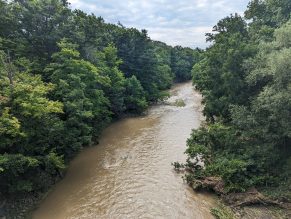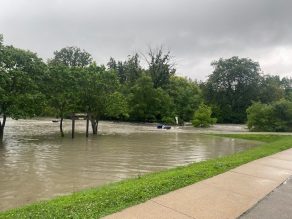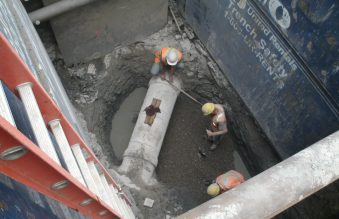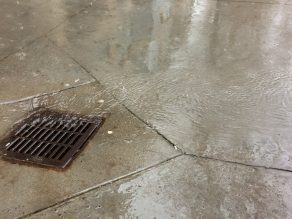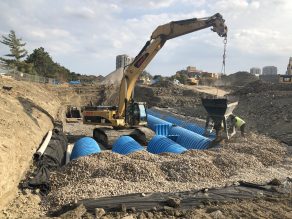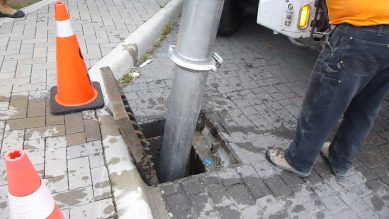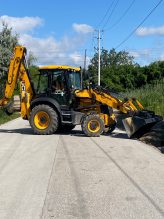Mississauga’s stormwater infrastructure helps against a 100-year storm
The City’s stormwater infrastructure helped to mitigate the impact of this near-record rainfall, demonstrating its role in assisting with protecting the city during extreme weather events.
Environment | July 23, 2024
A critical, but largely invisible, infrastructure system helped the city from being completely washed away by flooding last week. Stormwater is the rain or melted snow that flows or runs off properties and roads and drains along streets, ditches, storm drains, and watercourses into Lake Ontario. The City’s stormwater infrastructure helped to mitigate the impact of this near-record rainfall, demonstrating its role in assisting with protecting the city during extreme weather events.
On July 16, Mississauga experienced a ‘100-year storm’ with approximately 106 mm of rainfall in only a few hours – much more than the average 75 mm Mississauga typically receives for the entire month of July. Heavy rains falling in a short period of time caused high water levels and localized flooding on roads and along creeks, rivers and streams.
While some parks flooded, trails washed out, embankments eroded, debris flowed into neighbourhoods, and some residents experienced property damage like basement flooding or water pooling in their backyards – it would have been worse without the City’s stormwater infrastructure actively managing the situation. It handled the majority of the unusual quantity of rain as a result of its network of underground pipes, designated stormwater ponds, culverts and overland flow routes along roadways.
About Mississauga’s stormwater system
Separate from the sanitary wastewater system, the City’s stormwater system collects stormwater from properties and carries it to a receiving waterbody. Maintaining this system lessens the risk of flooding, reduces creek erosion and protects water quality. This is important as it protects you, your property, aquatic habitats, wildlife and Lake Ontario.
Projects funded by the City’s stormwater charge, such as the construction of Lake Saigon—a stormwater management pond at Matheson Blvd E. and Hurontario Street—protected flood-susceptible lands downstream within the Cooksville Creek watershed. These infrastructure improvements were key in mitigating the impact of flooding within the city, highlighting the importance of the City’s stormwater charge as a critical investment.
The stormwater system serves to safeguard the city against unpredictable storms of this scale, helping to protect our communities and the lives of residents. Last June, the City approved its first Stormwater Master Plan, Build Beautiful. The approved long-term plan will refine the City’s stormwater program, management systems, and infrastructure. It will help the City address issues facing Mississauga today and, in the future, including flooding, water quality, and pollution while working to preserve our environment.
Climate change and rainfall
With climate change unfolding, we will see storms like this happen more frequently. Every degree of temperature change, even one degree warmer, can impact our environment significantly. This could mean more widespread flooding with rainfall levels expected to increase in volume and intensity, with more frequent and intense precipitation. It’s important that we manage stormwater to reduce flooding risk to your property, lower erosion of our creeks and limit the amount of pollution entering Lake Ontario.
This isn’t the first time Mississauga has experienced heavy rains. On July 8, 2013, more than 10 years ago, the city experienced a storm where more than 126 mm of rain was recorded at Toronto Pearson airport over a stretch of 10 hours. Another recorded storm was in 1954 –Hurricane Hazel, which dropped more than 200 mm of rain over Mississauga in 24 hours.
Stormwater infrastructure is sized to convey flows based on “peak intensity.” For example, 50 mm of rain falling intensely over two hours is more likely to cause issues in the urban environment than if 50 mm of rain fell slowly over two days. In addition to peak intensity, the total amount of rain can overwhelm storm drainage systems. For example, 50 mm of rain requires greater system capacity than 5 mm. These two factors (intensity and total rainfall) help define storms by assigning a probability of occurrence or specific return period. More intense and higher-volume storms occur theoretically less often, whereas less intense, lower-volume storms can occur several times every year. A so-called ‘100-year storm’ has a probability of occurring of 1 per cent on any given year.
Currently, the City has more than 1,900 kilometres of storm sewer pipes in its drainage system. If laid out end-to-end, these pipes would connect Mississauga to Winnipeg. The stormwater drainage system also includes more than 51,000 catchbasins, 270 kilometres of ditches, 150 kilometres of creeks, and 81 stormwater management facilities (including ponds, underground storage, and Low-Impact Development facilities) that help to collect, drain, and clean the city’s rainwater runoff before it enters Lake Ontario, the source of our drinking water.
Stormwater charge
The Stormwater Charge has made a real difference in the delivery of the City’s stormwater program. It helps with the operations and maintenance of our stormwater systems including necessary activities like cleaning out our catchbasins. These collect rain and snow melt to provide property and road drainage in neighbourhoods, and also trap debris, preventing litter and pollutants from flowing to our creeks.
The stormwater drainage system is one of the largest assets owned and operated by the City of Mississauga. The 2024 Corporate Asset Management Plan estimated a replacement value of $7.6 billion.
The need for continued infrastructure funding
Over the next 10-years, the City’s Stormwater Program to build, expand, and maintain our stormwater system is fully funded because of the self-funded stormwater charge. However, there is still a need to appropriately contribute to the Pipe Reserve Fund to allow for the future replacement of the City’s aging storm water pipes.
The City is seeking a commitment from all levels of government and is advocating for additional funding to help bridge the infrastructure gap. This is crucial for underlining priorities, such as stormwater infrastructure, that are vital to the safety of our community.
Clean up efforts and restoration of business operations
The City continues with clean up efforts including the removal of debris from sidewalks, roads and trails. Several of the City’s parks and sports fields remain closed as repair work is completed.
Learn more about the City’s stormwater program and dedicated charge here.
Read the 2023-2027 Stormwater Business Plan
Watch our stormwater video.
Tags
Media contact
City of Mississauga Media Relations
media@mississauga.ca
905-615-3200, ext. 5232
TTY: 905-896-5151
